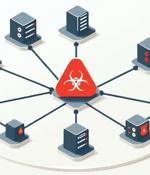Security News > 2024 > February

Exposed Docker API endpoints over the internet are under assault from a sophisticated cryptojacking campaign called Commando Cat. "The campaign deploys a benign container generated using...

The FBI has disrupted the KV botnet, used by People's Republic of China state-sponsored hackers to target US-based critical infrastructure organizations. A botnet for probing critical infrastructure organizations.

Using a panel of 709 volunteers who shared archives of their Facebook data, Consumer Reports found that a total of 186,892 companies sent data about them to the social network. On average, each participant in the study had their data sent to Facebook by 2,230 companies.

How’s your vulnerability management program doing? Is it effective? A success? Let’s be honest, without the right metrics or analytics, how can you tell how well you’re doing, progressing, or if...

The U.S. government on Wednesday said it took steps to neutralize a botnet comprising hundreds of U.S.-based small office and home office (SOHO) routers hijacked by a China-linked state-sponsored...

Cybersecurity researchers have detailed an updated version of the malware HeadCrab that's known to target Redis database servers across the world since early September 2021. The development, which...

A financially motivated threat actor tracked as UNC4990 is using booby-trapped USB storage devices and malicious payloads hosted on popular websites such as Ars Technica, Vimeo, GitHub and GitLab to surreptitiously deliver malware. Another interesting detail about UNC4990 it's mostly targeting organizations located in Italy and is likely based in that country, as well.

Google-owned Mandiant said it identified new malware employed by a China-nexus espionage threat actor known as UNC5221 and other threat groups during post-exploitation activity targeting Ivanti Connect Secure VPN and Policy Secure devices.This includes custom web shells such as BUSHWALK, CHAINLINE, FRAMESTING, and a variant of LIGHTWIRE.

You've probably heard it before: zero trust is not a single product, but a security strategy that follows the principle of "Never trust, always verify". Implementing zero trust means an overall change in technology and architecture, and doing it one step at the time.

Security teams need not take a binary approach to the tradeoff of fast scanning vs. vulnerability detection. How significant is the ability to write custom rules in security tools for organizations, and what impact does this have on the effectiveness of vulnerability detection?